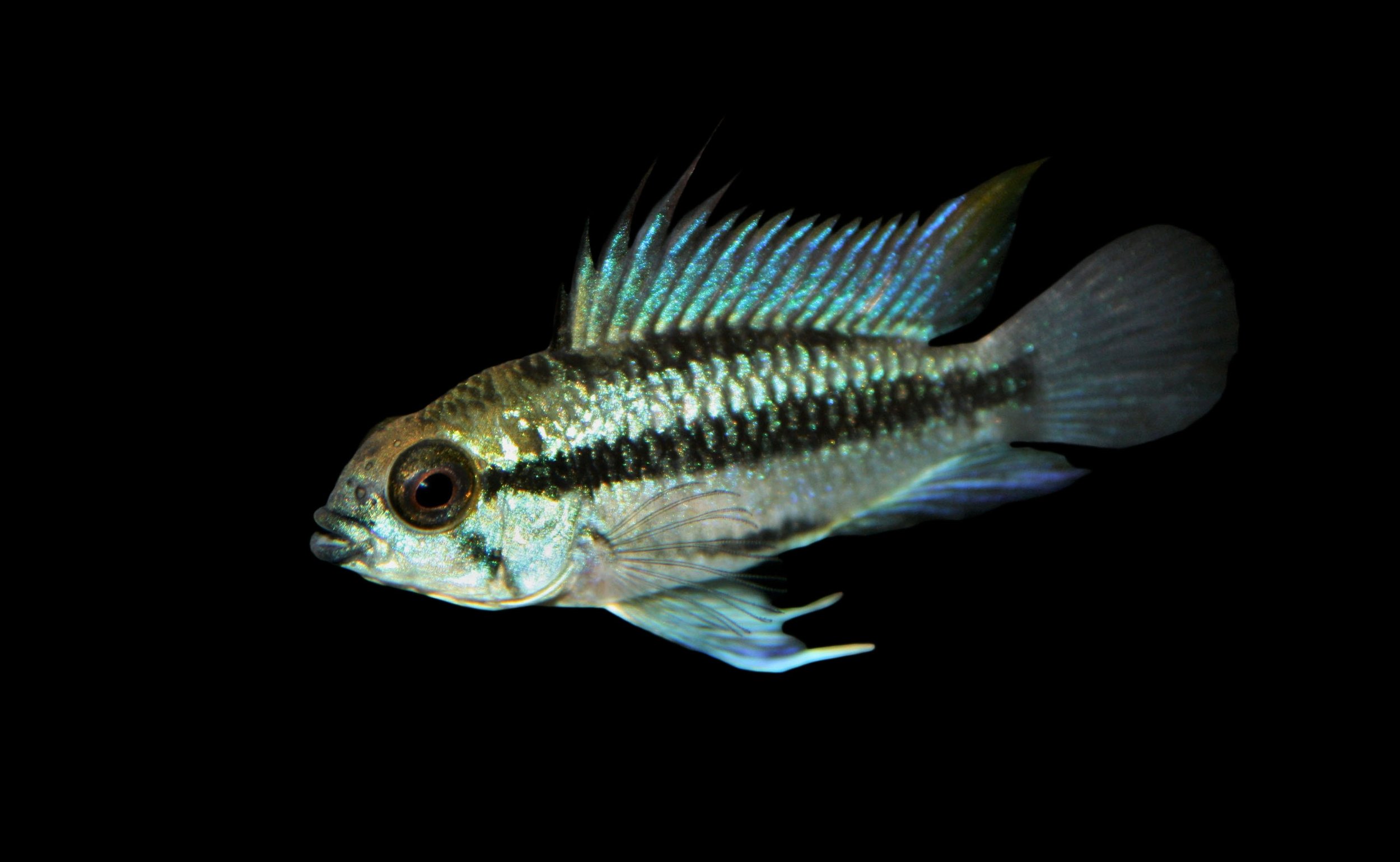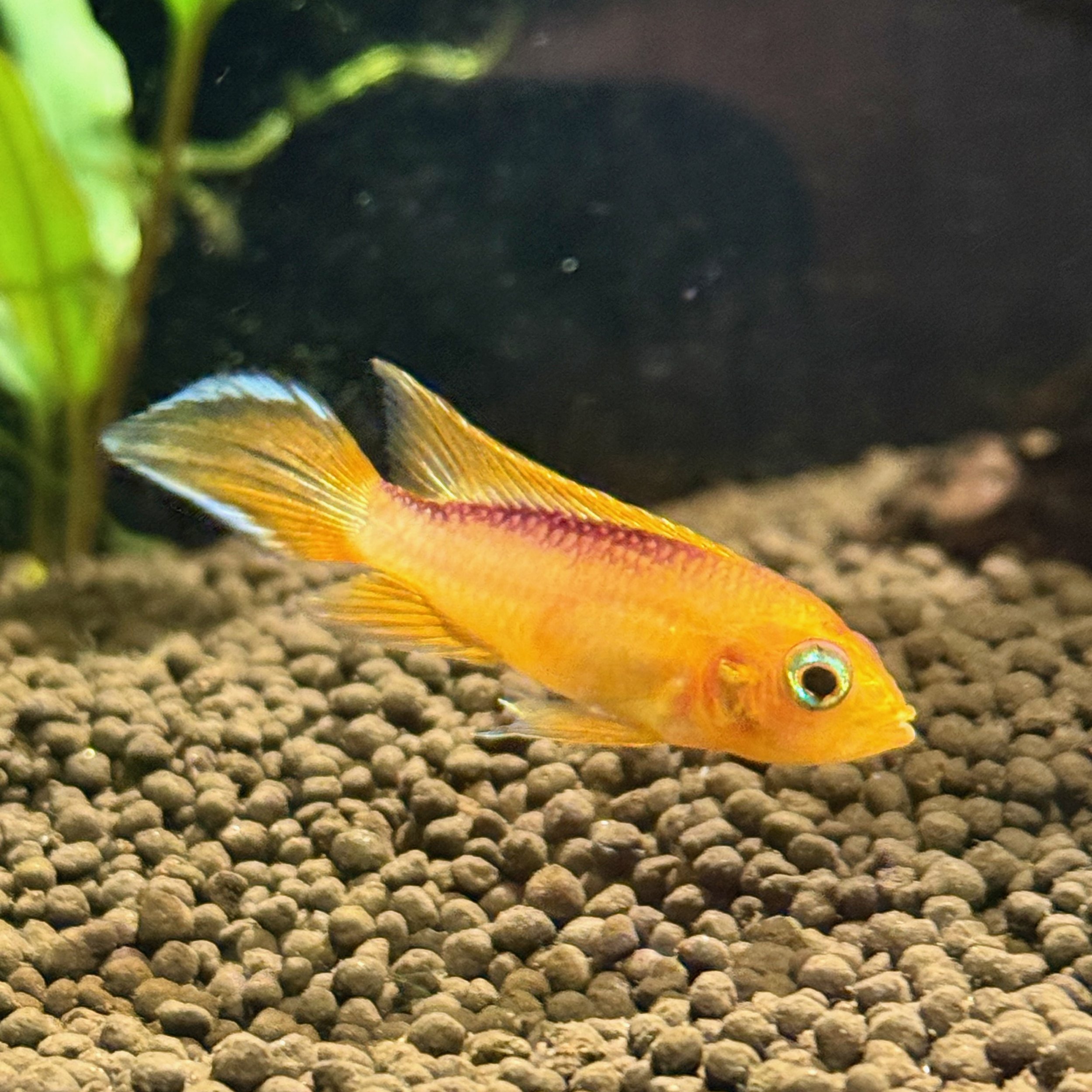 Image 1 of
Image 1 of


Nannacara anomala-UNSEXED
Nannacara anomala, commonly known as the Golden Dwarf Cichlid or simply the Anomala Cichlid, is a small and attractive species of cichlid that has long been favored by aquarists for its vibrant coloration, manageable size, and relatively peaceful nature. Native to the coastal rivers and floodplains of the Guianas in South America, this species is well-suited to a variety of aquarium setups, particularly those that mimic its natural habitat.
Physically, Nannacara anomala is a small cichlid, with males typically reaching about 3 inches (7.5 centimeters) in length, while females are slightly smaller, usually around 2.5 inches (6 centimeters). The males are particularly striking, with a golden-yellow to olive-green body color that can vary in intensity depending on their mood and breeding condition. The scales of the males often have a metallic sheen, and their fins are edged with vibrant blue or green highlights, making them particularly eye-catching during courtship displays. Females, while less colorful, exhibit a more subdued coloration that can range from brownish to pale yellow, often with a distinctive dark lateral line and spots that become more pronounced during breeding.
In the aquarium, Nannacara anomala thrives in a well-planted environment with plenty of hiding spots provided by driftwood, rocks, and dense vegetation. These fish are relatively peaceful for cichlids, making them suitable for community tanks with other small, non-aggressive species. However, they can become territorial, particularly during breeding, so providing sufficient space and hiding places is important to minimize aggression. Good tank mates include small tetras, rasboras, Corydoras catfish, and other peaceful dwarf cichlids.
Water parameters for Nannacara anomala should mimic their natural habitat in the soft, slightly acidic waters of the Guianas. They prefer a pH range of 6.0 to 7.5 and temperatures between 72 to 82°F (22 to 28°C). While these fish are adaptable to a range of water conditions, regular water changes and good filtration are essential to maintain their health and well-being.
Feeding Nannacara anomala is straightforward, as they are omnivorous and will accept a variety of foods. They thrive on a diet that includes high-quality flakes or pellets, supplemented with live or frozen foods such as brine shrimp, bloodworms, and daphnia. Offering a varied diet will help enhance their coloration and overall vitality.
Breeding Nannacara anomala in captivity is relatively easy, making them a good choice for aquarists interested in breeding dwarf cichlids. They are substrate spawners, and during breeding, the female will lay eggs on a flat surface, such as a rock, or within a cave. The female takes primary responsibility for guarding the eggs and fry, while the male will defend the territory. The eggs typically hatch within 2 to 3 days, and the fry become free-swimming after another 4 to 5 days. The fry can be fed on infusoria or finely powdered fry food initially, followed by baby brine shrimp as they grow.
Overall, Nannacara anomala is a beautiful and manageable cichlid species that can add a touch of color and interest to a freshwater aquarium. With proper care and attention to their specific needs, these fish can thrive and bring joy to aquarists of all levels, offering both visual appeal and the potential for successful breeding in a home aquarium.
Nannacara anomala, commonly known as the Golden Dwarf Cichlid or simply the Anomala Cichlid, is a small and attractive species of cichlid that has long been favored by aquarists for its vibrant coloration, manageable size, and relatively peaceful nature. Native to the coastal rivers and floodplains of the Guianas in South America, this species is well-suited to a variety of aquarium setups, particularly those that mimic its natural habitat.
Physically, Nannacara anomala is a small cichlid, with males typically reaching about 3 inches (7.5 centimeters) in length, while females are slightly smaller, usually around 2.5 inches (6 centimeters). The males are particularly striking, with a golden-yellow to olive-green body color that can vary in intensity depending on their mood and breeding condition. The scales of the males often have a metallic sheen, and their fins are edged with vibrant blue or green highlights, making them particularly eye-catching during courtship displays. Females, while less colorful, exhibit a more subdued coloration that can range from brownish to pale yellow, often with a distinctive dark lateral line and spots that become more pronounced during breeding.
In the aquarium, Nannacara anomala thrives in a well-planted environment with plenty of hiding spots provided by driftwood, rocks, and dense vegetation. These fish are relatively peaceful for cichlids, making them suitable for community tanks with other small, non-aggressive species. However, they can become territorial, particularly during breeding, so providing sufficient space and hiding places is important to minimize aggression. Good tank mates include small tetras, rasboras, Corydoras catfish, and other peaceful dwarf cichlids.
Water parameters for Nannacara anomala should mimic their natural habitat in the soft, slightly acidic waters of the Guianas. They prefer a pH range of 6.0 to 7.5 and temperatures between 72 to 82°F (22 to 28°C). While these fish are adaptable to a range of water conditions, regular water changes and good filtration are essential to maintain their health and well-being.
Feeding Nannacara anomala is straightforward, as they are omnivorous and will accept a variety of foods. They thrive on a diet that includes high-quality flakes or pellets, supplemented with live or frozen foods such as brine shrimp, bloodworms, and daphnia. Offering a varied diet will help enhance their coloration and overall vitality.
Breeding Nannacara anomala in captivity is relatively easy, making them a good choice for aquarists interested in breeding dwarf cichlids. They are substrate spawners, and during breeding, the female will lay eggs on a flat surface, such as a rock, or within a cave. The female takes primary responsibility for guarding the eggs and fry, while the male will defend the territory. The eggs typically hatch within 2 to 3 days, and the fry become free-swimming after another 4 to 5 days. The fry can be fed on infusoria or finely powdered fry food initially, followed by baby brine shrimp as they grow.
Overall, Nannacara anomala is a beautiful and manageable cichlid species that can add a touch of color and interest to a freshwater aquarium. With proper care and attention to their specific needs, these fish can thrive and bring joy to aquarists of all levels, offering both visual appeal and the potential for successful breeding in a home aquarium.
Nannacara anomala, commonly known as the Golden Dwarf Cichlid or simply the Anomala Cichlid, is a small and attractive species of cichlid that has long been favored by aquarists for its vibrant coloration, manageable size, and relatively peaceful nature. Native to the coastal rivers and floodplains of the Guianas in South America, this species is well-suited to a variety of aquarium setups, particularly those that mimic its natural habitat.
Physically, Nannacara anomala is a small cichlid, with males typically reaching about 3 inches (7.5 centimeters) in length, while females are slightly smaller, usually around 2.5 inches (6 centimeters). The males are particularly striking, with a golden-yellow to olive-green body color that can vary in intensity depending on their mood and breeding condition. The scales of the males often have a metallic sheen, and their fins are edged with vibrant blue or green highlights, making them particularly eye-catching during courtship displays. Females, while less colorful, exhibit a more subdued coloration that can range from brownish to pale yellow, often with a distinctive dark lateral line and spots that become more pronounced during breeding.
In the aquarium, Nannacara anomala thrives in a well-planted environment with plenty of hiding spots provided by driftwood, rocks, and dense vegetation. These fish are relatively peaceful for cichlids, making them suitable for community tanks with other small, non-aggressive species. However, they can become territorial, particularly during breeding, so providing sufficient space and hiding places is important to minimize aggression. Good tank mates include small tetras, rasboras, Corydoras catfish, and other peaceful dwarf cichlids.
Water parameters for Nannacara anomala should mimic their natural habitat in the soft, slightly acidic waters of the Guianas. They prefer a pH range of 6.0 to 7.5 and temperatures between 72 to 82°F (22 to 28°C). While these fish are adaptable to a range of water conditions, regular water changes and good filtration are essential to maintain their health and well-being.
Feeding Nannacara anomala is straightforward, as they are omnivorous and will accept a variety of foods. They thrive on a diet that includes high-quality flakes or pellets, supplemented with live or frozen foods such as brine shrimp, bloodworms, and daphnia. Offering a varied diet will help enhance their coloration and overall vitality.
Breeding Nannacara anomala in captivity is relatively easy, making them a good choice for aquarists interested in breeding dwarf cichlids. They are substrate spawners, and during breeding, the female will lay eggs on a flat surface, such as a rock, or within a cave. The female takes primary responsibility for guarding the eggs and fry, while the male will defend the territory. The eggs typically hatch within 2 to 3 days, and the fry become free-swimming after another 4 to 5 days. The fry can be fed on infusoria or finely powdered fry food initially, followed by baby brine shrimp as they grow.
Overall, Nannacara anomala is a beautiful and manageable cichlid species that can add a touch of color and interest to a freshwater aquarium. With proper care and attention to their specific needs, these fish can thrive and bring joy to aquarists of all levels, offering both visual appeal and the potential for successful breeding in a home aquarium.







